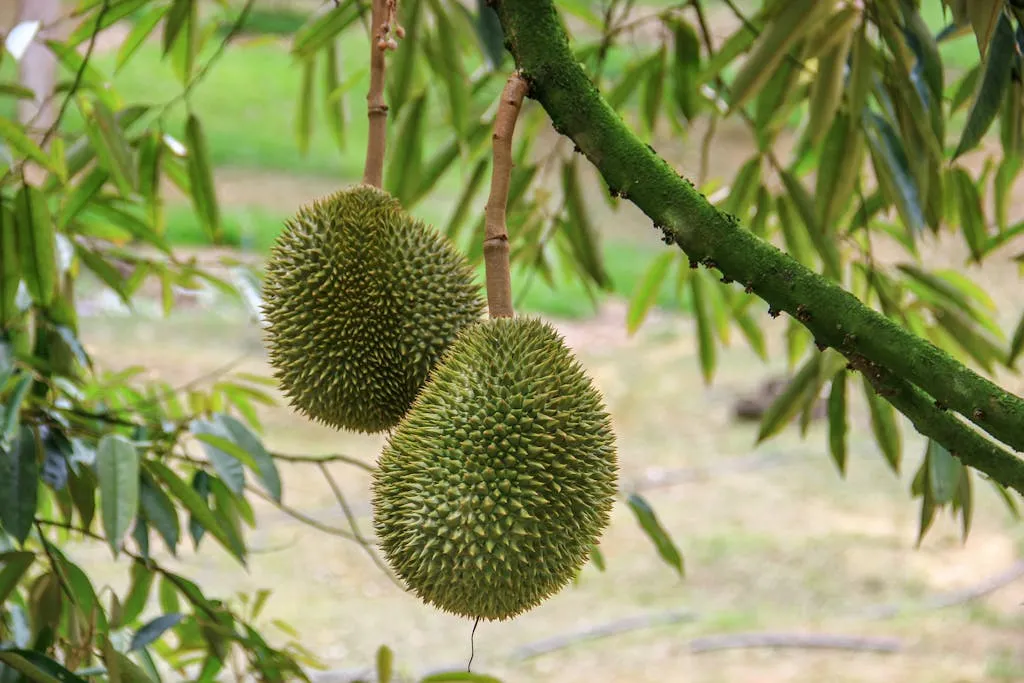Durian – The King of Fruits (with a pungent twist!)
Table of Contents
What is Durian?
The Durian (Durio zibethinus) is a truly unique and controversial fruit native to Southeast Asia. Often called the “king of fruits,” it’s as beloved as it is divisive, thanks to its distinctive appearance and pungent odor.

What is it?
- Appearance: Durian is large and oval-shaped, covered in a thick, green-yellow rind with sharp, spiky thorns. It looks like a medieval weapon!
- Aroma: This is the most distinctive feature. Durian has a powerful, pungent smell that’s hard to describe. Some find it intensely fragrant and enticing, while others find it overpowering and unpleasant. Words like “rotten onions,” “gym socks,” and “caramel” are often used to describe it.
- Taste: The flesh inside is creamy, custard-like, and has a rich, sweet, and complex flavor with hints of savory notes. It’s an acquired taste, but many who try it become addicted.
Why is it so special?
- “King of Fruits”: Durian is often called the “King of Fruits” in Southeast Asia due to its unique taste, aroma, and status.
- Nutritional Value: Durian is surprisingly nutritious, packed with fiber, vitamins, minerals, and healthy fats.
How To Select And Open A Durian?
Important Durian Safety Tip:
- Avoid mixing durian with soda or alcohol. This combination can be very dangerous, as it can lead to indigestion, bloating, and other uncomfortable side effects.
- If you’re bothered by the strong smell of durian, here’s a trick: Store the durian in a box and add coffee powder. The coffee will help absorb the odor. This is especially useful if you’re traveling with durian in your car.
Durian: Indonesian Culinary Creations
In Indonesia, durian is a culinary star, incorporated into a wide array of sweet and savory dishes.
- From Savory to Sweet:
- Savory: Durian can be found in savory dishes like sop durian (durian soup) and even pizza durian, offering unique flavor combinations.
- Sweet: The most popular forms are sweet treats:
- Pancakes, ketan (sticky rice), and bubur (porridge) are classic Indonesian dishes elevated with the addition of durian.
- Ice cream, milkshakes, and es lilin (ice pops) offer refreshing durian-flavored treats.
- Cakes like bolu, pudding, and strudel, and pastries like klapertart and pie showcase durian’s versatility.
- Candies, kue sus (cream puffs), and martabak manis (sweet pancake) offer bite-sized durian indulgence.
What month is durian season in Indonesia?
Generally, Indonesia experiences two main durian seasons each year:
- End-of-year/Early-year Season (December to February): This is the second peak season. During these months, durians are widely available again.
- Mid-year Season (June to August): This is one of the peak seasons where many regions across Indonesia experience abundant durian harvests.
Can you eat durian in Bali?
Yes, You Can Eat Durian in Bali! Durian is readily available in Bali, especially during its peak season, which typically starts in November. You can find it at local markets, fruit stalls, and even some supermarkets.
